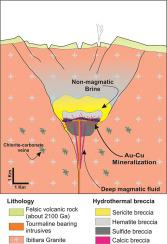Ore Geology Reviews ( IF 3.2 ) Pub Date : 2021-03-31 , DOI: 10.1016/j.oregeorev.2021.104148 Leandro Duarte Campos , Claudinei Gouveia de Oliveira , Carlos E Ganade , Elton Luiz Dantas

|
Lavra Velha is a newly discovered Rhyacian IOCG deposit in the northern portion of the São Francisco Craton, in the Bahia state of NE Brazil. Gold and copper mineralization is hosted by epigenetic hydrothermal breccia with large amounts of iron oxide. Multiple phases of breccia formation and hydrothermal alteration caused zoning from the base to the top of the deposit. The alteration is mainly characterized by hydrothermal calcite-epidote-magnetite, tourmaline-chlorite-magnetite, and sericite-hematite hydrothermal alteration styles. Tourmaline and chlorite chemistry indicates that low temperature alkaline fluids had variable Fe2+, Mg, Al, and Na contents throughout the evolution of the breccia complex. Magnetite and hematite display low vanadium content (≤0.24 wt%) and very low titanium content (≤0.06 wt%). The sulfide minerals are pyrite (with up to ~ 3 wt% Co), chalcopyrite, bornite, arsenopyrite, and covellite, in decreasing order of abundance. Coarse muscovite that is related to the latest stages of breccia displays a high barium content with an average of ≥ 1.27 wt%. Isotopic compositions of carbon and oxygen in calcite from the calcic breccia indicate that early mineralizing fluids were derived from a mixed magmatic/non-magmatic reservoir (δ13C ~ −2‰ and δ18O from 9.95 to 13.09‰ in calcite). The sulfur isotopic compositions of chalcopyrite and pyrite demonstrate that sulfur in the mineralized breccia was derived from cooling magmas that underwent weak contamination from oxidized fluids or host rocks (δ34S from 2.22 to 3.89‰). New U-Pb zircon ages indicate that mineralization occurred at approximately 2100 Ma, coeval with tourmaline-bearing porphyritic granite dikes that yield ages of 2098 ± 8 and 2112 ± 12 Ma respectively. Despite being considered a small deposit in relation to known reserves, Lavra Velha may be the first IOCG deposit recognized in the São Francisco Craton, particularly in the Gavião Block. Thus, it represents an important indicator for future precious and base metal exploration in the São Francisco Craton.
中文翻译:

巴西圣弗朗西斯科·克拉顿的Rhyacian Lavra Velha富金IOCG矿床的成矿作用
Lavra Velha是巴西NE州巴伊亚州SãoFrancisco Craton北部新发现的Rhyacian IOCG矿床。金和铜的矿化是由表观成因的热液角砾岩和大量的氧化铁共同控制的。角砾岩形成和热液蚀变的多个阶段导致了沉积物底部到顶部的分区。蚀变主要表现为水热方解石-闪石-磁铁矿,电气石-绿泥石-磁铁矿和绢云母-赤铁矿热液蚀变样式。电气石和亚氯酸盐化学表明低温碱性流体具有可变的Fe 2+角砾岩复合体演化过程中的Mg,Al和Na含量。磁铁矿和赤铁矿显示出低的钒含量(≤0.24wt%)和非常低的钛含量(≤0.06wt%)。硫化物矿物是黄铁矿(含不超过3 wt%的钴),黄铜矿,褐铁矿,毒砂和co石,其含量按降序排列。与角砾岩的最新阶段有关的粗白云母显示出高的钡含量,平均≥1.27wt%。从钙的角砾方解石碳和氧的同位素组成表明,早期矿化流体从混合岩浆/非岩浆储衍生(δ 13 C〜-2‰和δ 18O为方解石中的9.95至13.09‰。黄铜矿和黄铁矿的硫同位素组成展示矿化角砾硫是来自经历弱污染从氧化流体或主岩(δ冷却岩浆衍生34期从2.22到3.89‰)。新的U-Pb锆石年龄表明,成矿作用发生在大约2100 Ma,与电气石含斑岩花岗岩堤坝并存,其年龄分别为2098±8和2112±12 Ma。尽管相对于已知储量而言,拉夫拉·维利亚矿床虽然被认为是少量储量,但它可能是圣弗朗西斯科·克拉顿(SãoFrancisco Craton),尤其是加维奥区块(GaviãoBlock)中公认的首批IOCG储量。因此,它代表了圣弗朗西斯科·克拉顿未来贵重金属和贱金属勘探的重要指标。











































 京公网安备 11010802027423号
京公网安备 11010802027423号